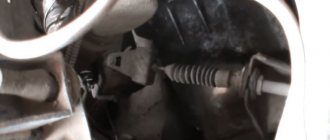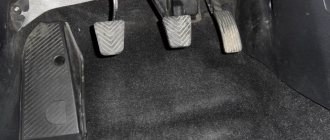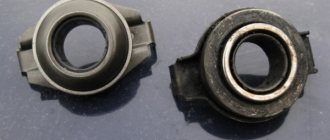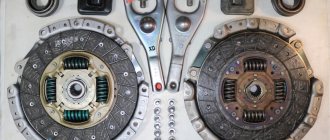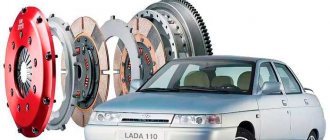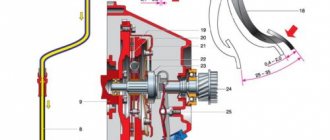I once saw a post on the tape about the tension of the throttle cable. I decided to try it myself.
So, we remove the decorative plate and see this picture.
We see a cable going to the throttle valve. By default, the bracket on the cable was set to the 8th division. The cable itself is slightly loosened; the throttle regulator rests against the throttle body with its limiter.
We take out the cable with the rubber band that holds it in place and remove the metal. bracket, put back the cable with the rubber band and pull the cable to the right until we feel the free movement end and the throttle valve begins to open. We put the bracket back.
It turned out that free play is selected at the 11-12th division. (you can see in photo 3 that the damper regulator no longer rests against the body with the limiter, but moves away by 3-4mm). This way we create a light preload. As a result, free play is removed from the gas pedal. And even with a slight touch of the gas pedal, the throttle valve is immediately actuated, which improves reaction time and responsiveness to the gas pedal.
I haven't driven much yet, about 20 km. But the impressions are only positive. It became easier to get underway, immediate response to the gas pedal, more predictable reaction. I really liked it. I regret that I didn’t do it earlier))
I'll keep watching for now. But today, perhaps due to the heat, the injection was slightly increased by 14-25%. (consumption at idle = 0.8-0.9 l/h) Usually this figure is around 2-5% injection and 0.7-0.8 l/h consumption at idle. But the revs didn't increase. For now I'll chalk it up to the heat.
At the same time I looked at the recently replaced valve cover gasket. Everything is fine, dry).
The design of the gas pedal is practically no different from the clutch pedal; time does its job with the gas pedal. After a certain period of time, the pedal begins to work incorrectly, pressing on the gas we have to press the pedal to the floor for anything to happen, or vice versa, the pedal travel is too small and as soon as we touch the gas pedal, a rapid increase in speed begins. Both options are very inconvenient for us, because we are accustomed to something in between. This makes it easier to drive a car in a style that has already been developed over the years. After all, regardless of the factory, the pedal travel in all cars is different, even if you compare 2 absolutely identical cars, their control will be different. Therefore, drivers who are accustomed to driving in the same style and with the same sensitivity of the car want to preserve this feeling and transfer it with it to another car.
How to install the cable?
I will tell you how to replace the throttle cable on a VAZ 2110. To do this, you need a screwdriver (flat), a new cable, side cutters and pliers with flat jaws. First of all, remove the plastic engine protection. Then remove the safety bracket from the throttle assembly sector, prying it off with a screwdriver. Then we pull the cable tip out of the groove and disconnect the cable. Then remove the spring stopper using pliers (Figure 3).
And we pull out our cable from the slots of the holder (Fig. 4). We cut through the plastic clamp that tightly clamped our cable to the gas ventilation hose (Fig. 5). Next, we move the cable sheath forward (Fig. 6). We take out the cable sheath damper from the front end (Fig. 7). Disconnect the cable in the cabin under the gas pedal (Fig. 
That's it, now we can pull out the cable and replace it with a new one, doing all the operations in reverse order. Do not forget to secure the cable to the gas ventilation hose with a plastic clamp.
The last step in tuning is adjusting the throttle.
Throttle adjustment
To make adjustments, we only need pliers. When starting adjustments, first remove the plastic engine casing. Next, disconnect the air supply hose from the throttle body pipe. Then the assistant fully presses the gas pedal to the floor, in this position the throttle valve should be fully open. Accordingly, when the pedal is lowered, the throttle valve should be completely closed.
In other cases, the throttle valve needs to be adjusted. To adjust, remove the spring stop (Fig. 3). Move the cable sheath (1) and adjust the free play of the cable. When we finish this operation, install the stopper tightly to the rubber bushing (2) (Fig. 4).
This completes all gas pedal settings.
How to adjust the throttle cable on a VAZ 2110-VAZ 2112
Body VAZ 2110 2111 2112 Removing the front bumper VAZ 2110 2111 2112
Note! A lot of engines were installed on cars of the tenth family, ranging from carburetor 1.5 to injection 16 valve engines. Let us immediately warn you that carburetor engines from the Samara family were installed on dozens, and we already have information on adjusting all the valves on carburetor Samaras and it is posted in two article, the first is called: “Adjusting the throttle valves”, the second: “Adjusting the air damper”, so if you have a carburetor, then go straight to them, because in this article we are talking only about injection cars and we will not touch on carburetor cars!
1) Let’s write briefly because there is nothing complicated in the adjustment, and there are not many nuances, in general, let’s start with the throttle valve closed (This is when the gas pedal is released and nothing presses on it), so if it is not completely closed, then the adjustment it can be done using a cable, but it is not always possible to adjust the position of the closed damper with a cable, so the adjusting screw comes into play, which is located on the throttle assembly itself (see photo 1), you will either need to tighten it, or, on the contrary, loosen it a little, thereby achieving a completely closed damper (And it shouldn’t jam yet, keep this in mind), but you need to be careful with this screw, if you tighten it too much, the car will simply stall or won’t start at all, and if you unscrew it too much, the idle speed will increase, fuel consumption will be the same and the throttle will be slightly open, but the easiest way is to adjust it by speed, for example, on a warm engine, your idle used to be 800 rpm, you will need to start the car, warm it up in the same way and adjust this screw so that again there were 800 revolutions on the tachometer needle as before, we’re done with adjusting the damper, proceed to adjusting the cable on 8 valve cars, look for the place where the cable connects to the bracket (see. photo 2), once you have found it, take two wrenches and rotate the adjusting nuts (Nut 1 and 2) with them, adjust the cable as you need (It is allowed to sag a little, do not tighten the cable too much), 16 valve cars are also adjusted in the same way , there a metal plate is pulled out with pliers or by hand (see photo 3) and after which the cable is adjusted by moving it (To the back and to the front, see photo 4), as soon as the tension suits you (Remember, do not overtighten it ) the plate is inserted into its place and the adjustment is complete; at the end, check whether the throttle valve opens completely when the pedal is pressed all the way and whether it closes.
Note! Let's say a few words about the adjusting screw, the most important thing is not to confuse it with any other screws (For example, with screws A, by the way, they cannot be turned out at all), it stands on the side, for clarity, in the photo below it is indicated by an arrow with the letter B!
Additional video: Using the example of a Renault Logan car, look at how the cable is adjusted, it applies to 16 valve cars; on dozens with a 124 engine, this adjustment is done almost exactly the same way.
Note!" And regarding 8-valve machines, see the cable adjustment a little lower; by the way, it also applies to some 16-valve machines (If the intake manifold is not plastic, but aluminum)!
Throttle cable
The intermediate link between the accelerator pedal and the throttle valve is a cable. It is the correct tension of the throttle drive cable that allows you to get maximum power from the engine and its stable operation at idle. After all, weak cable tension can cause the throttle valve not to open fully and, accordingly, the engine will not develop maximum power. A overtightened cable can cause even more problems. Indeed, in such a situation, the throttle valve may not close completely and suck air into the manifold, increasing engine speed. But this is not the worst thing. The fact is that the ECU judges engine load largely by relying on sensors in the throttle valve. These sensors are the throttle position sensor and the throttle valve closing sensor. The latter is a simple electrical contact.
Namely, when the cable is adjusted correctly, when the gas pedal is released, the valve closes as much as possible, closing the contacts, which in turn gives the ECU a command to close the throttle valve. The ECU switches the engine to idle mode.
Tips and tricks
Before starting any adjustments, you need to clearly understand what result needs to be achieved as a result of the automatic transmission settings. If you need smooth shifting, the cable needs to be loosened (the cable is lengthened when one adjusting nut is unscrewed and the other is tightened).
Also, we should not forget that the throttle cable and its adjustment also help influence the operation of the automatic transmission. The main thing is to perform each operation correctly, clearly understanding what result this or that action will lead to. If everything is done correctly, the result will be a carefully tuned automatic transmission, and for a specific driver.
Why the automatic transmission kicks, the automatic transmission jerks when changing gears, jerks, jerks and impacts occur in the automatic transmission: the main reasons.
Automatic transmission slipping when changing gears: the main reasons why an automatic transmission slips. Box diagnostics, troubleshooting.
The automatic transmission does not change gears: the car does not move forward or backward, the automatic transmission does not switch to individual gears, reasons.
Is it possible to tow a car with an automatic transmission: basic rules and recommendations. What you need to consider if a car with an automatic transmission is towing another car.
Automatic transmission selector: basic functions. Types of automatic transmission selectors: steering column, push-button, floor. Malfunction of the automatic transmission selector.
Driving a car with an automatic transmission: how to use an automatic transmission, operating modes of an automatic transmission, rules for using this transmission, tips.
- Accelerator cable - what goes behind the gas pedal?
- What is an accelerator cable and its malfunctions?
- Adjusting the accelerator cable?
- Replacing the accelerator cable
It often happens that at the most inopportune moment the gas, clutch or hood breaks. Of course, the worst thing is if this happens while the car is moving. In this article we will look at problems associated with the accelerator cable, its adjustment and replacement. The accelerator cable is one of the main elements, without which it is impossible to start the car. There can be many reasons for replacing the accelerator cable, but the main one can be identified when the speed freezes. You drive without thinking, calmly, press the gas pedal, level off, release the accelerator, and the tachometer needle shows the same speed. The car continues to pick up speed without any intervention from the driver. In this case, the worst thing will be the emergence of confusion, bordering on a panic attack, in inexperienced drivers, when they simply do not know what to do in this case.
What is an accelerator cable and its malfunctions?
Due to this state of affairs, when you press the pedal all the way and then remove your foot from it, the car not only continues to drive, but also picks up speed further! Although the pedal will eventually return to its original position, remember that such jokes with the accelerator cable can end in failure.
If a similar situation ever happens to you, then remember several postulates of behavior in such a case. First, no matter how much the throttle is opened and no matter how powerful the engine is, the brakes will still “pull their weight” and stop the vehicle even with the throttle fully open. Second, press the accelerator pedal sharply and release it just as sharply. In this case, it is possible that the cable will come out of its engagement point and return to its normal position.
Adjusting the accelerator cable?
Poor, delayed or untimely response to the accelerator pedal is often a sign of obvious problems with the throttle cable. The problem may also be hidden in an incorrectly adjusted cable, loose tension, or, conversely, its severe stretching and complete failure, which requires immediate replacement. If, when pressing the gas pedal, you feel resistance similar to friction, or pressing the pedal is no longer smooth, then you should lubricate the accelerator cable. To complete the work you will need:
– a syringe with motor oil or WD-40.
Let's proceed directly to the work itself.
1. First, turn off the engine and let it cool.
2. Then open the hood and remove the decorative engine cover.
3. To remove the accelerator cable, remove it from the plastic bracket. Pull the cable casing towards you and remove the cable by sliding the rubber ring up.
4. Now disconnect the cable from the throttle valve drive. To do this, remove the metal U-shaped bracket from its drive by prying one edge of it with a metal screwdriver.
5. Pull the cable out of the hook, overcoming the force of the spring.
6. Now that the cable is free and nothing is bothering you, start lubricating the throttle drive. Slide off the clear cap and generously lubricate the cable with a couple of drops of motor oil or WD-40 coating fluid. If you will use oil, then prepare a syringe. Pour oil into the housing, and then use vigorous movements to distribute the lubricant along the entire length of the cable. The procedure will need to be repeated several times until the entire cable is completely lubricated. Then put the protective cap on it and install the cable in the reverse order in its place.
Incorrect throttle cable adjustment
If the overtightened cable prevents the contacts from closing, then the ECU will never know that the driver has released the gas pedal all the way and will control the engine in partial load mode rather than idling.
Lacetti ECU sensor diagram
For several years now, either dying down or flaring up again with renewed vigor, the topic of tensioning the Lacetti gas pedal cable has been circulating on the Internet. Its essence is that if you tighten the cable, the car stops twitching when changing gears, etc.
Having read this, inexperienced car enthusiasts immediately run to pull the cable tighter. They tighten it and problems begin with engine speed, the position of the throttle lock at idle, and the like.
The cable tension must be strictly monitored. But this must be done correctly and without fanaticism.
Adjusting the Lacetti throttle cable
The only tool you need is a 10mm socket wrench to remove the engine trim. I don’t think there’s any need to tell you how to remove it.
Here we see such a picture
To tighten the throttle control cable, you need to remove this clamp
It can be easily removed with bare hands
After this, pull the cable casing to the right until the sagging of the cable becomes minimal and insert the lock back. In this case, the cable was stretched four notches. The arrow shows its previous position
If the cable is adjusted correctly, then when you press the gas pedal, the throttle should open completely, and when released, it should close completely. Moreover, there must be a gap in this place for the smooth operation of the IAC, since on the Lacetti 1.4 and 1.6, the IAC directly controls the throttle valve.
Attention! This gap is not constant and depends on whether the ignition is on or off, as well as on the temperature of the coolant when the ignition is on or the engine is running! Therefore, there is no need to adjust this gap!
And you need to make sure that when you release the gas pedal, the shoulder at the back rests against its stop. Then the gap will be normal.
Therefore, it is necessary to check the adjustment not by the sag of the cable, but by the fit of the collar! Do not pull on the cable to remove any slack! Make sure that the shoulder rests against its stop and then give the pedals 2-3 mm of free play. There must be free movement. This way you will eliminate the influence of the cable on the operation of the IAC!
We start the engine and check the operation of the drive and watch the idle speed. They should remain at the same level. If they have increased, it means the cable is overtightened.
You can also look at the adequate response of opening/closing the damper in the Chevrolet Explorer program
How to properly maintain and change the throttle cable
Chassis front and rear suspension VAZ 2110 2111 2112 Removing the lever and extension of the front suspension VAZ 2110 2111 2112
Any element of the cable drive requires periodic adjustment. The metal gradually stretches, and play appears, which not only irritates the driver, but also reduces driving safety. You press the gas pedal with a certain force, expect adequate acceleration from the car, but the engine spins up with a delay. If wedged into traffic on a busy highway, this can lead to an accident.
There is always an adjusting screw on the cable sheath.
The photo shows two nuts with which the overall tension of the drive can be adjusted within a few centimeters:
By moving the threaded bushing, you move the stop point (and therefore the zero force point) closer or further from the carburetor throttle lever.
- It is necessary to evaluate the free play of the pedal (before the damper begins to move). For this you will need an assistant. At your command, he slowly presses the pedal, and you fix the free play of the cable. Mark the setting point of the damper and make a mark with a marker;
- Then, having loosened the fastening, tighten the shell using the nut, which is located on the pedal side. Having fixed the point at which the damper begins to move (at the mark with a marker), unscrew the nut half a turn back and tighten it with the second nut. Again ask the assistant in the cab to slowly press the pedal. If the play is no more than a millimeter, the adjustment is complete. Otherwise, repeat the setup;
- If, when the pedal is released, the damper is slightly open, you will get the effect of an extended choke lever. At idle speed the crankshaft will spin faster than expected. In general, you will end up with excessive fuel consumption;
- And of course, cable lubrication. It is enough to apply it in a small amount to the entry points into the shell.


